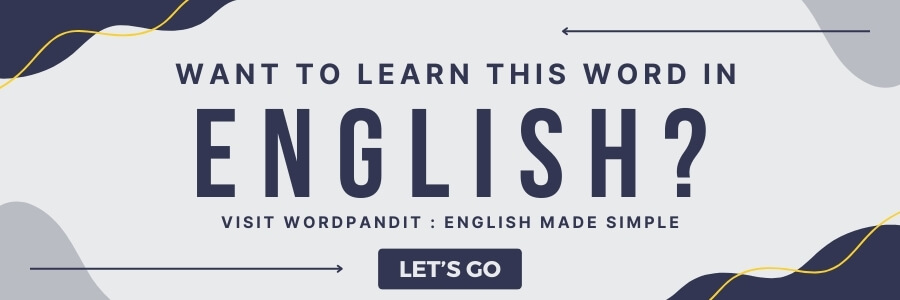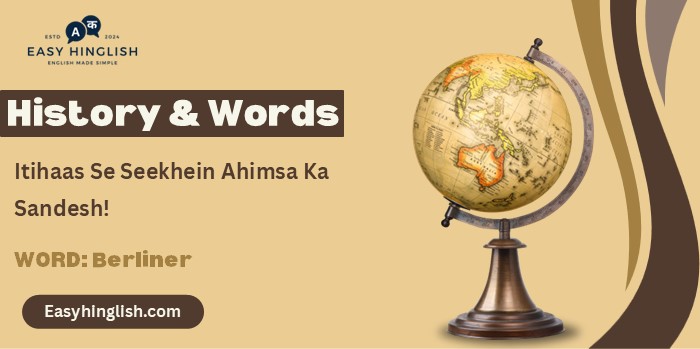History & Words: 'Berliner' (November 9)
Welcome to 'History & Words.' Main Prashant hoon, Wordpandit aur Learning Inc. Network ka sansthapak. Yeh series meri bhasha seekhne ki lagan aur itihas ke prati ruchi ka sangam hai. Har kadi ek shabd aur uss se judi ek tithi par roshni daalti hai, jisse aapka shabdkosh badhta hai aur aap itihas ko gehraai se samajh paate hain. Aaiye, iss safar mein shabdon ke madhyam se samay mein pichhe chalein.
🔍 Word of the Day: Berliner
Pronunciation: /bərˈliːnər/ (ber-LEE-ner)
🌍 Parichay (Introduction)
9 November 1989 ki raat Berlin mein history ka sabse joyous moment witness hua. 28 saal tak divide karne waali Berlin Wall finally gir gayi, aur "Berliner" identity ko naya meaning mil gaya. East aur West Berliners jo decades se concrete barrier se separate the, woh hammers aur pickaxes leke wall tod rahe the. "Mauerspechte" (wall woodpeckers) kehte the unhe – jo freedom ki awaaz mein wall ko piece by piece destroy kar rahe the.
Berliner sirf geographical identifier nahi tha – yeh resilience, division, aur reunification ka symbol tha. 1961 se 1989 tak Berlin duniya mein sabse divided city tha, jahan same nationality ke log physically separate kar diye gaye the. November 9th ne prove kiya ki human spirit kisi bhi artificial barrier se strong hoti hai.
Yeh din Cold War ka end symbolize karta hai. Iron Curtain which had divided Europe for nearly half a century finally lifting ho raha tha. Berliners ke celebration mein entire world participate kar raha tha, kyunki yeh moment freedom aur unity ki universal victory thi.
🌱 Shabd ka Utpatti (Etymology)
"Berliner" German word hai jo "person from Berlin" meaning karta hai. German mein city names ke saath "-er" suffix lagake residents identify karte hain: Münchener (from Munich), Hamburger (from Hamburg). Simple linguistic rule, but political complications ne ise complex bana diya.
1961-1989 period mein "Berliner" identity politically loaded tha. East Berliners officially "citizens of the German Democratic Republic" the, while West Berliners technically "under Allied occupation" the, not full West German citizens. Yeh administrative complexities ne Berliner identity ko unique banaya.
"Ich bin ein Berliner" – John F. Kennedy ka famous 1963 statement ne iss word ko global recognition diya. Ironically, some German speakers point out ki literally yeh "I am a jelly donut" mean kar sakta hai (Berliner = type of pastry), but context mein everyone understood political solidarity ka message.
📖 Mahatvapurn Shabdavali (Key Vocabulary)
- 🔑 Iron Curtain: Metaphorical barrier dividing Eastern and Western Europe during Cold War
- 🔑 Checkpoint Charlie: Famous border crossing point between East and West Berlin
- 🔑 Ostalgie: Nostalgia for aspects of life in former East Germany
- 🔑 Reunification: Process of East and West Germany becoming one country again
- 🔑 Peaceful Revolution: Non-violent political change in East Germany (1989)
- 🔑 Mauerfall: German term for "fall of the wall"
🏛️ Itihasik Sandarbh (Historical Context)
Berlin ka division World War II ke aftermath mein start hua. 1945 mein Allied powers (US, UK, France, Soviet Union) ne Germany ko four occupation zones mein divide kiya. Berlin, though East Germany ke andar located, bhi four sectors mein split hua. Initially temporary arrangement tha, but Cold War tensions ne ise permanent division bana diya.
1948-49 mein Berlin Blockade ne situation critical kar diya. Soviet Union ne West Berlin ko land routes se cut off kar diya, forcing Berlin Airlift – Allied powers ne aircraft se supplies deliver kiye. Yeh event ne West Berlin ko freedom ka symbol establish kar diya.
1961 mein East German government ne overnight Berlin Wall construct kar diya. "Antifaschistischer Schutzwall" (Anti-Fascist Protection Rampart) officially kaha, but reality mein yeh East Germans ko escape karne se rokne ke liye tha. Barbed wire se start ho kar concrete wall ban gaya – 12 feet high, 96 miles long.
Wall ne families, friends, lovers ko separate kar diya. Dramatic escape attempts regularly hote the: tunnels, hot air balloons, hidden car compartments. Peter Fechter, Chris Gueffroy jaise young people freedom ke liye life sacrifice kar diye. Death strip mein guards shoot-to-kill orders the.

⏳ Samayrekha (Timeline)
- 1945: Germany aur Berlin divided into occupation zones
- 1948-49: Berlin Blockade and Airlift
- 1961: Berlin Wall construction begins (August 13)
- 1963: JFK's "Ich bin ein Berliner" speech
- 1987: Reagan's "Tear down this wall!" speech
- 1989: East German government announces border opening (Nov 9)
- 1990: German reunification (October 3)
- 1991: Berlin becomes capital of unified Germany
🌟 Is Din ka Mahatva (The Day's Significance)
9 November 1989 ko East German government ne mistakenly announce kar diya ki border crossings immediately open hain. Party spokesman Günter Schabowski ne press conference mein confusing statement diya about new travel regulations. Jab unse pucha gaya "When does this take effect?", unhone kaha "immediately" – though actually proper procedures supposed to start next day.
East Berliners ne TV broadcast dekha aur thousands checkpoint par pahunch gaye. Border guards confusion mein the – no clear orders, huge crowds, aur mounting pressure. 11:30 PM pe guards ne finally gates open kar diye, aur history change ho gayi.
Scenes absolutely euphoric the. East aur West Berliners hugging, crying, celebrating together after 28 years of separation. Champagne bottles Brandenburg Gate pe opened, strangers danced together, families reunited after decades. "Die Mauer ist weg!" (The wall is gone!) chants echoed throughout Berlin.
International media live coverage kar raha tha. Tom Brokaw, Dan Rather, Peter Jennings – major American anchors Berlin mein present the. Mikhail Gorbachev ka glasnost aur perestroika policies ne Soviet control weaken kiya tha, making peaceful transition possible.
Wall destruction immediately start hua. "Mauerspechte" (wall woodpeckers) hammers, pickaxes, chisels leke concrete chunks collect kar rahe the as souvenirs. Berlin government later official demolition arrange kiya, but citizen participation symbolic tha – people power artificial barriers tod sakti hai.
💬 Prasiddh Ukti (Quote)
"Ich bin ein Berliner!" (I am a Berliner!)
— John F. Kennedy, June 26, 1963
🔮 Aaj Ka Matlab aur Chintan (Modern Usage and Reflection)
Aaj "Berliner" identity unified hai, but memories aur experiences still different hain East aur West ke logon mein. "Ossis" (East Germans) aur "Wessis" (West Germans) terms abhi bhi casual conversation mein use hote hain. Economic disparities aur cultural differences 30+ years baad bhi exist karte hain.
Berlin today vibrant, multicultural capital hai. Tech startups, art scene, nightlife – city completely transformed ho gayi hai. "New Berliners" from all over world city ko international hub bana rahe hain. Startup ecosystem particularly strong hai – European Silicon Valley ka status emerging hai.
Wall remnants ab tourist attractions hain. East Side Gallery, Checkpoint Charlie Museum, Brandenburg Gate – yeh sites Cold War history preserve karte hain future generations ke liye. Educational purpose important hai – younger generations ko division ka reality samjhaane ke liye.
🏛️ Virast (Legacy)
Berlin Wall fall ne domino effect create kiya. Eastern European communist governments one by one collapse hue: Poland, Hungary, Czechoslovakia, Romania. Soviet Union itself 1991 mein dissolve ho gaya. November 9, 1989 essentially 20th century ka end aur new world order ka beginning tha.
"Berliner" resilience global symbol ban gaya hai. Divided cities worldwide – Belfast, Jerusalem, Nicosia – mein Berlin model reference kiya jaata hai. Peace walls aur barriers ko temporary believe karna, not permanent solutions.
European Union ka expansion eastward largely Berlin Wall fall ka result hai. Single currency, open borders, cultural exchange – yeh sab November 9th se possible hua. "Unity in diversity" European motto Berlin reunification se inspired hai.
🔍 Tulnatmak Vishleshan (Comparative Analysis)
1989 mein Wall fall spontaneous aur peaceful tha. Government announcement se citizen action tak sirf few hours. No violence, no bloodshed – contrast with other revolutionary movements jo years of struggle require karte hain. Communication technology (TV, radio) ne rapid mobilization possible banaya.
Aaj digital age mein barriers different nature ke hain: internet censorship, digital walls, social media echo chambers. "Great Firewall of China" modern equivalent hai physical walls ka. Information freedom aaj ka primary concern hai, not just physical movement.
Contemporary wall debates – US-Mexico border, Israeli separation barrier, India-Pakistan border – mein Berlin Wall lessons relevant hain. Short-term security vs long-term human connections ka cost-benefit analysis policy makers ke liye crucial hai.
💡 Kya Aapko Pata Hai? (Did You Know?)
🎓 Antim Vichar (Conclusion)
"Berliner" identity November 9, 1989 ke baad completely redefined ho gayi. Division se unity, separation se celebration, barriers se bridges – yeh transformation human spirit ki power demonstrate karta hai. Wall jo families aur communities divide kar raha tha, uska destruction collective joy ka moment tha.
Aaj Berlin thriving capital hai, but wall ka memory preserved hai education aur reminder ke liye. "Never again" sentiment strong hai – artificial divisions temporary hote hain, human connections eternal hain. Berliner identity aaj openness, resilience, unity represent karti hai.
📚 Aage Padhne Ke Liye (Further Reading)
- 📘 The Fall of the Berlin Wall: The Revolutionary Legacy of 1989 – Jeffrey A. Engel
- 📗 Stasiland: Stories from Behind the Berlin Wall – Anna Funder
- 📙 The Berlin Wall: A World Divided, 1961-1989 – Frederick Taylor








